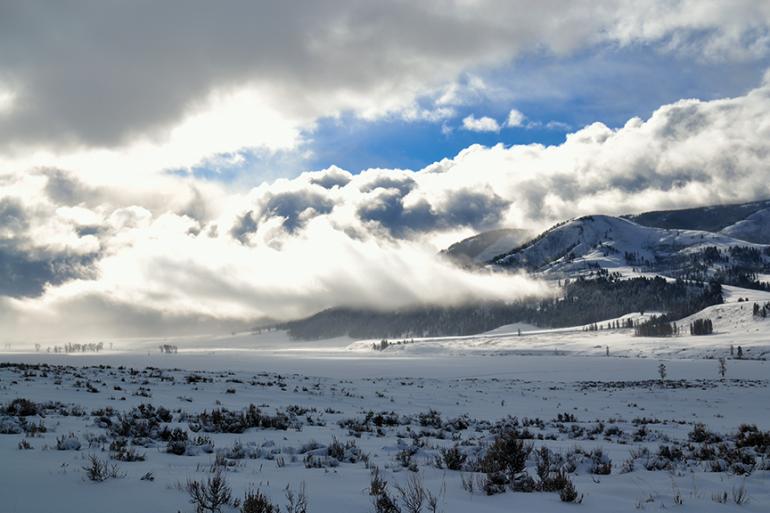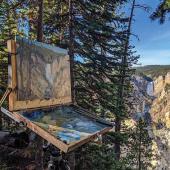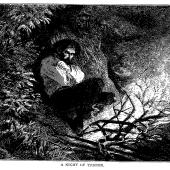Framing Yellowstone
Twelve of us stood huddled by cameras on tripods under the cold sky, lenses aimed into the night. His breath coming out in clouds, our instructor Tom waded through the snow, popping an external flash onto the walls of the log cabin in front of us. As soon as our shutters snapped shut, everyone leaned in to see millions of previously invisible stars and a bright cabin appear on their screen like a magic trick. Following a few gasps and a little laughter, it was back to fiddling with f-stops and ISO settings to make the next shot even better.
My screen didn’t show the infinite sprawling cosmos. It blinked MEMORY CARD FULL, almost pleading for mercy. 1,800 shots were enough. Instead of trying to cull bad photos to make extra room, I just packed up my gear and crunched through the snow back to my cabin, browsing through half a week of landscapes, hot springs, buffalo, waterfalls, and sunsets. Being on my camera was no guarantee they were worth a damn, but with our recent classroom sessions on workflow and Photoshop wizardry, they now had the best possible chance.
For our four-day Yellowstone Forever Institute (YFI) photo intensive, we were headquartered at the Lamar Buffalo Ranch: a quaint, rustic spread that once served as the last hope for buffalo in Yellowstone. By 1907, there were only 28 bison left in the Park, so rangers corralled them into the Lamar Ranch and helped foster their numbers. Only 30 years later, over 4,200 bison were successfully reintroduced into the Park. Now, sporting a renovated bunkhouse and 13 cozy guest cabins, the Ranch is a field campus for the YFI.
Coming in from seven different states, the 11 other attendees covered the entire gamut of photographic experience: one guy hauled along an $18,000, three-foot lens complete with its own tripod, while another woman asked if Canon made Nikon cameras—the photographic equivalent of wondering if Pepsi makes Coke. Regardless of ability, our instructors Terry Donnelly and Tom Kirkendall spoke in clear terms that veterans and newbies alike could understand and enjoy. With over 50 years of photographic experience between them, they’d ridden the changing tides of film to digital and both thrived as professional photographers when not teaching.
Time behind the lens was first priority, but the class was more than just bussing us to wildlife and landscape hotspots like Mammoth or Pebble Creek and letting us wear out our shutters. The course was designed to help us break away from the standard “point and pray” method that dominated the majority of photography in the Park. Aiming your camera at a charging buffalo or rocketing geyser was secondary to deeper aspects—there was actually an array of elusive factors to consider: composition, lines, form, lighting, depth. “Just because there’s something interesting in your photo doesn’t mean your photo will be interesting,” Terry told us.
This class taught the steps that most amateur photographers don’t take: learning the language and technical tools necessary to transform a photograph from an image to artwork. We learned that photography (like writing or music) is foremost a form of communication. But then, through knowledge and technique, it changes from communicating information to communicating beauty. The goal in our artistic endeavors was to have people view our photography aesthetically—as art instead of communication: a novella instead of a billboard, a sonata instead of a doorbell. The class provides a fundamental shift in thinking about pictures all together. “Don’t take a photograph—make a photograph,” Tom reminded us whenever the class was huddled around a scenic overlook or when an elk would trudge nearby.

But unlike writing or music, photography is somewhat misunderstood as a medium—largely because any idiot can buy $30,000 in camera gear, press a button, and look like a professional photographer—but that approach is akin to spending your life savings on a guitar and amp without ever even mastering “Smoke on the Water” by Deep Purple. “A camera is just a box,” Tom said. “What’s between your screen and lens is nothing compared to what’s between your ears.”
Every trip into the field was followed with classroom time, discussing the intricacies of flashes and lighting, post-production trickery, composition, and workflow techniques. In just a few days, RAW, JPEG, NEF, CR2, and TIFF all transformed from confusing acronyms to viable options for image storage. Like a Magic Eye poster, the veritable airplane cockpit of Photoshop’s interface began to change into an indispensable editing tool. Throughout the week, Terry would ask for a sample photo and doctor the hell out of it, changing levels, saturation, and dozens of other factors until the image leapt off the screen. The classroom time was useful, but unavoidably dense—whenever our instructors noticed too many eyes glazing over, they would pack us onto busses for more in-field work.
And just as quickly as we had arrived, we were packing up our things to leave—and giving surprisingly emotional goodbyes for a group that were all strangers just a few days ago. Every one of us left with a completely new understanding of the medium, and for anyone who loves Yellowstone (which is about all of us) and anyone who fancies himself an aspiring photographer (which is about half of us), this class was worth every nickel.
For more information on this course and others, check out yellowstone.org/experience/yellowstone-forever-institute.












